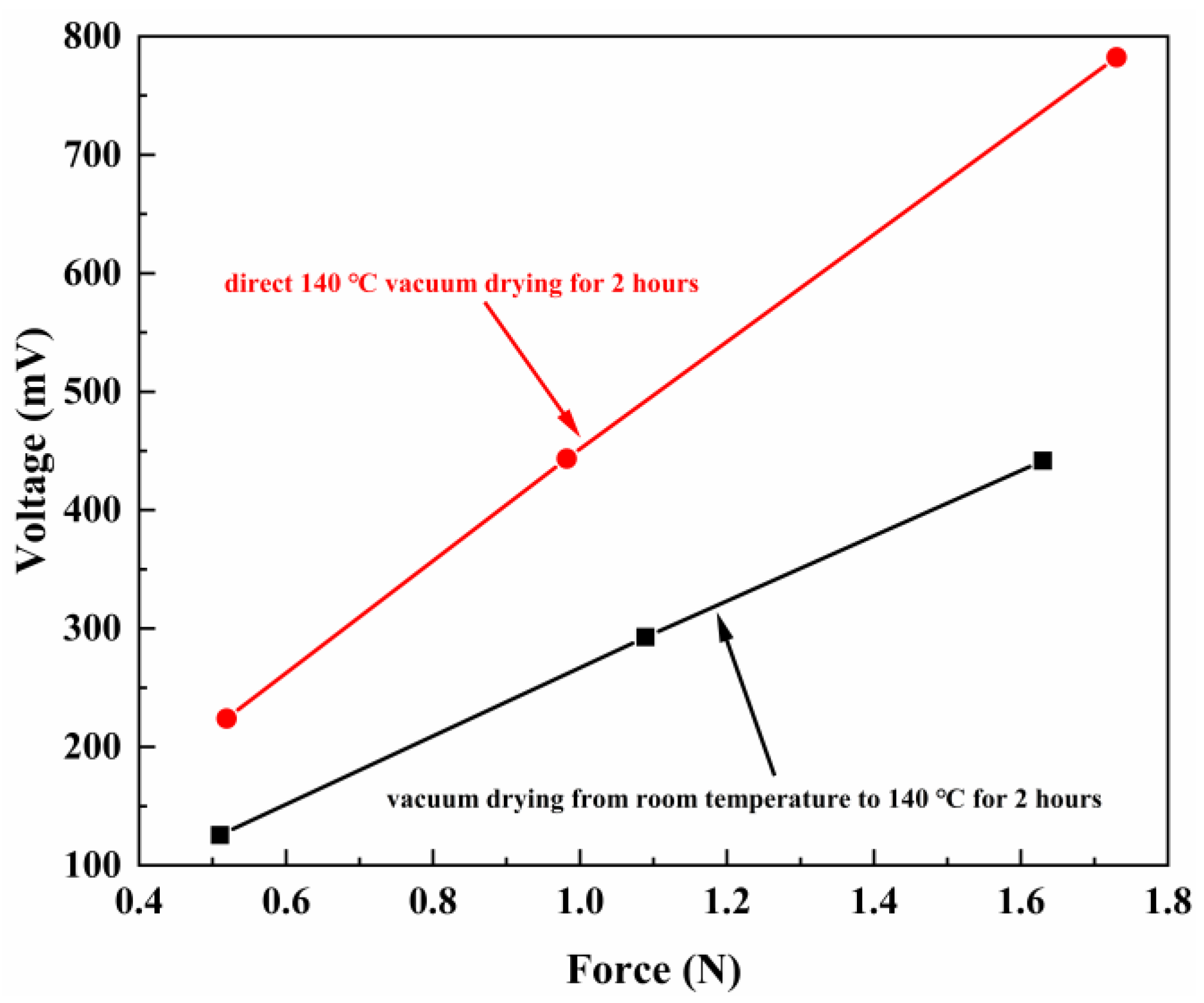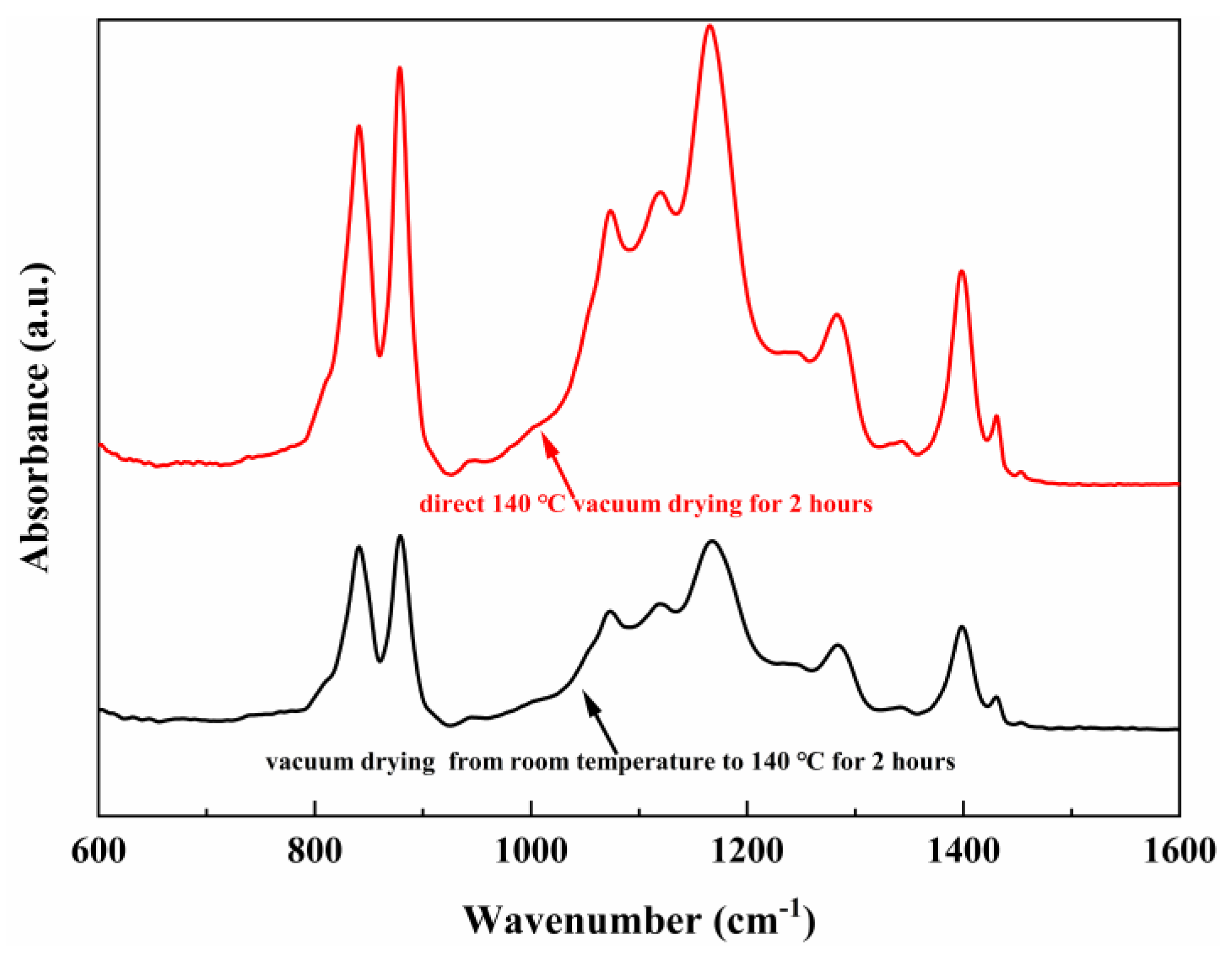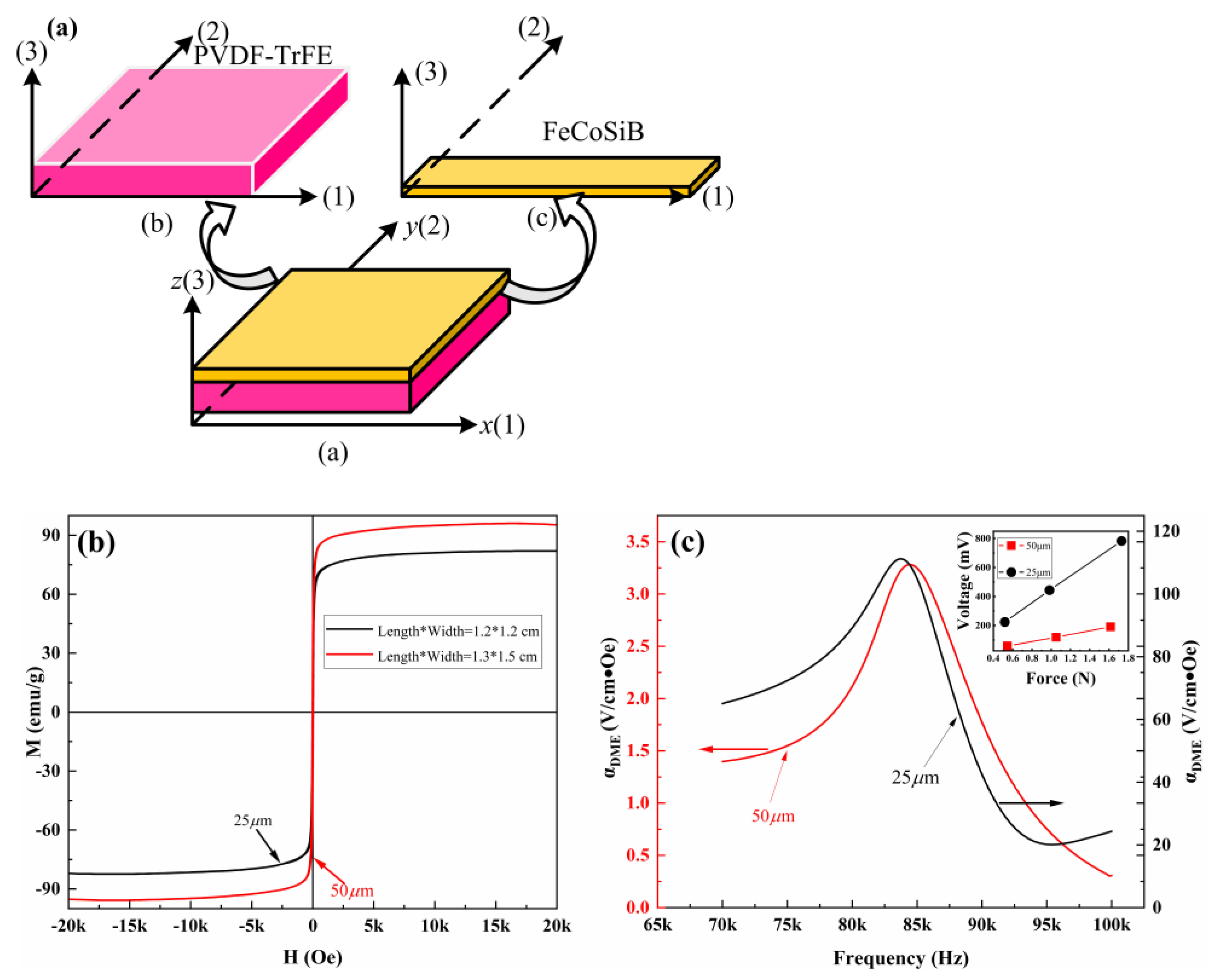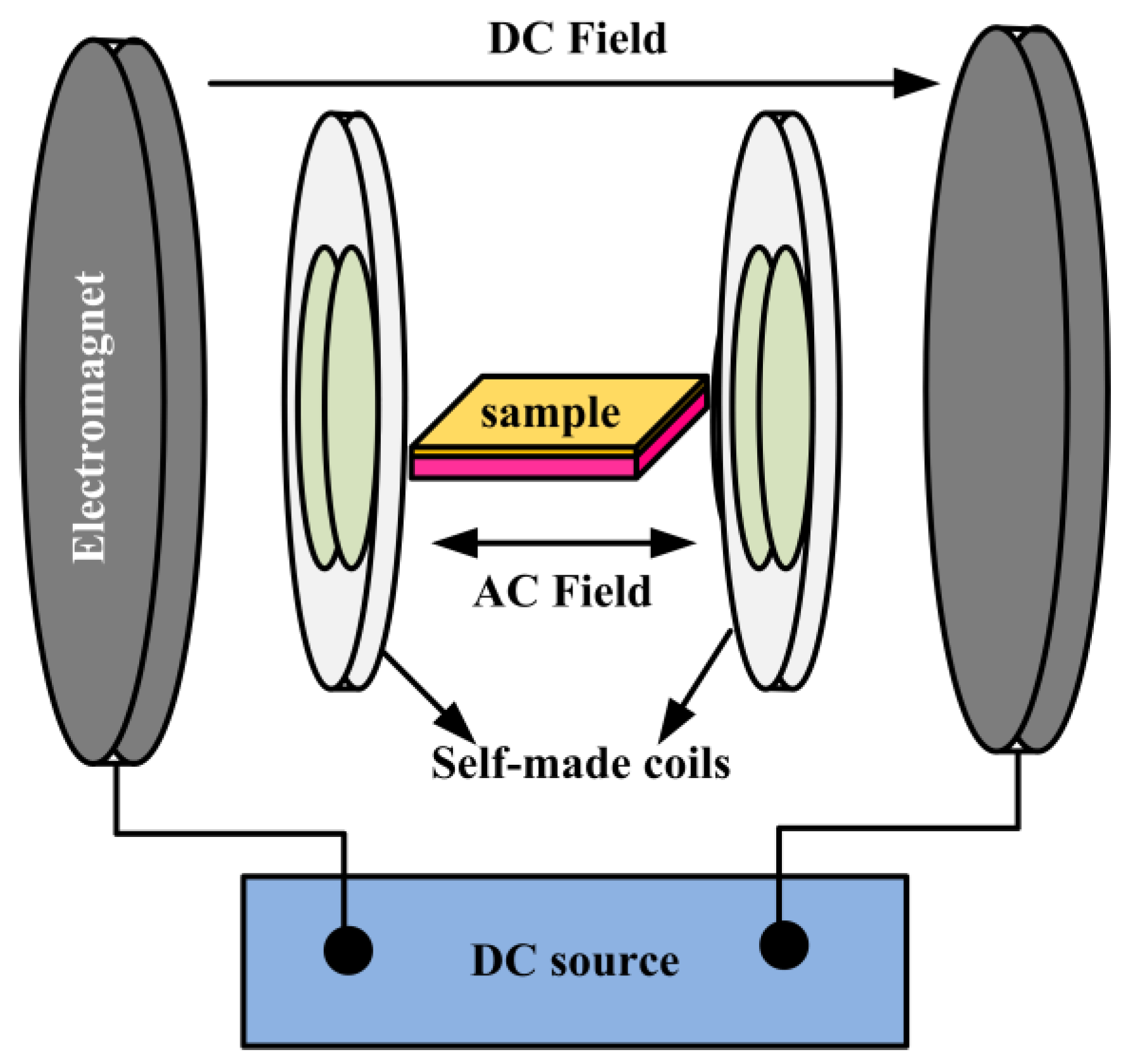Piezoelectric and Magnetoelectric Effects of Flexible Magnetoelectric Heterostructure PVDF-TrFE/FeCoSiB
Abstract
:1. Introduction
2. Results and Discussion
3. Materials and Methods
4. Conclusions
Author Contributions
Funding
Institutional Review Board Statement
Informed Consent Statement
Data Availability Statement
Conflicts of Interest
References
- Narayana, K.J.; Burela, R.G. A review of recent research on multifunctional composite materials and structures with their applications. Mater. Today 2018, 5, 5580–5590. [Google Scholar] [CrossRef]
- Leung, C.M.; Li, J.; Viehland, D.; Zhuang, X. A review on applications of magnetoelectric composites: From heterostructural uncooled magnetic sensors, energy harvesters to highly efficient power converters. J. Phys. D Appl. Phys. 2018, 51, 263002. [Google Scholar] [CrossRef]
- Turutin, A.V.; Vidal, J.V.; Kubasov, I.V.; Kislyuk, A.M.; Kiselev, D.A.; Malinkovich, M.D.; Parkhomenko, Y.N.; Kobeleve, S.P.; Kholkin, A.L.; Sobolev, N.A. Highly sensitive magnetic field sensor based on a metglas/bidomain lithium niobate composite shaped in form of a tuning fork. J. Magn. Magn. Mater. 2019, 486, 165209. [Google Scholar] [CrossRef]
- Pereira, N.; Lima, A.C.; Lanceros-Mendez, S.; Martins, P. Magnetoelectrics: Three centuries of research heading towards the 4.0 industrial revolution. Materials 2020, 13, 4033. [Google Scholar] [CrossRef] [PubMed]
- Sim, C.H.; Pan, A.Z.Z.; Wang, J. Thickness and coupling effects in bilayered multiferroic CoFe2O4/Pb(Zr0.52Ti0.48)O3 thin films. J. Appl. Phys. 2008, 103, 124109. [Google Scholar] [CrossRef]
- Spaldin, N.A.; Fiebig, M. The renaissance of magnetoelectric multiferroics. Science 2005, 309, 391–392. [Google Scholar] [CrossRef] [PubMed]
- Wang, X.Q.; Zhang, J.J.; Xia, X.D.; Fang, C.; Weng, G.J. Nonlinear magnetoelectric effects of polymer-based hybrid magnetoelectric composites with chain-like terfenol-D/epoxy and PVDF multilayers. Compos. Sci. Technol. 2021, 216, 109069. [Google Scholar] [CrossRef]
- Wang, X.Q.; Zhang, J.J.; Ta, W.R.; Xia, X.D.; Weng, G.J. Surface and interface effects on the bending behavior of nonlinear multilayered magnetoelectric nanostructures. Compos. Struct. 2021, 275, 114485. [Google Scholar] [CrossRef]
- Gao, J.Q.; Hasanyan, D.; Shen, Y.; Wang, Y.J.; Li, J.F.; Viehland, D. Giant resonant magnetoelectric effect in bi-layered Metglas/Pb(Zr,Ti)O3 composites. J. Appl. Phys. 2012, 112, 104101. [Google Scholar] [CrossRef] [Green Version]
- Rödel, J.; Jo, W.; Seifert, K.T.; Anton, E.M.; Granzow, T.; Damjanovic, D. Perspective on the development of lead-free piezoceramics. J. Am. Ceram. Soc. 2009, 92, 1153–1177. [Google Scholar] [CrossRef]
- Nguyen, A.N.; Solard, J.; Nong, H.T.T.; Ben Osman, C.; Gomez, A.; Bockelée, V.; Tencé, G.S.; Schoenstein, F.; Sorbed, S.M.; Carrillo, A.E.; et al. Spin coating and micro-patterning optimization of composite thin films based on PVDF. Materials 2020, 13, 1342. [Google Scholar] [CrossRef] [PubMed] [Green Version]
- Niu, Y.P.; Ren, H. A high efficiency standalone magnetoelectric energy converter based on Terfenol-D and PZT laminate. Appl. Phys. Lett. 2021, 118, 044101. [Google Scholar] [CrossRef]
- Ummer, R.P.; Sreekanth, P.; Raneesh, B.; Philip, R.; Rouxel, D.; Thomas, S.; Kalarikkal, N. Electric, magnetic and optical limiting (short pulse and ultrafast) studies in phase pure (1-x) BiFeO3-xNaNbO3 multiferroic nanocomposite synthesized by the pechini method. RSC Adv. 2015, 5, 67157–67164. [Google Scholar] [CrossRef]
- Ribeiro, C.; Costa, C.M.; Correia, D.M.; Nunes-Pereira, J.; Oliveira, J.; Martins, P.; Goncalves, R.; Cardoso, V.F.; Lanceros-Mendez, S. Electroactive poly (vinylidene fluoride)-based structures for advanced applications. Nat. Protoc. 2018, 13, 681–704. [Google Scholar] [CrossRef] [PubMed]
- Martins, P.; Kolen’ko, Y.V.; Rivas, J.; Lanceros-Mendez, S. Tailored magnetic and magnetoelectric responses of polymer-based composites. ACS. Appl. Mater. Inter. 2015, 7, 15017–15022. [Google Scholar] [CrossRef] [Green Version]
- Li, Y.H.; Feng, W.; Meng, L.; Tse, K.M.; Li, Z.; Huang, L.B.; Su, Z.Q.; Guo, S.F. Investigation on in-situ sprayed, annealed and corona poled PVDF-TrFE coatings for guided wave-based structural health monitoring: From crystallization to piezoelectricity. Mater. Des. 2021, 199, 109415. [Google Scholar] [CrossRef]
- Mayeen, A.; Kala, M.S.; Jayalakshmy, M.S.; Thomas, S.; Philip, J.; Rouxel, D.; Bhowmik, R.N.; Kalarikkal, N. Flexible and self-standing nickel ferrite–PVDF-TrFE cast films: Promising candidates for high-end magnetoelectric applications. Dalton T. 2019, 48, 16961–16973. [Google Scholar] [CrossRef]
- Kabir, E.; Khatun, M.; Nasrin, L.; Raihan, M.J.; Rahman, M. Pure β-phase formation in polyvinylidene fluoride (PVDF)-carbon nanotube composites. J. Phys. D Appl. Phys. 2017, 50, 163002. [Google Scholar] [CrossRef]
- Ruan, L.X.; Yao, X.N.; Chang, Y.F.; Zhou, L.Q.; Qin, G.W.; Zhang, X.M. Properties and applications of the β phase poly (vinylidene fluoride). Polymers 2018, 10, 228. [Google Scholar] [CrossRef] [Green Version]
- Cai, X.M.; Lei, T.P.; Sun, D.H.; Lin, L.W. A critical analysis of the α, β and γ phases in poly (vinylidene fluoride) using FTIR. RSC Adv. 2017, 7, 15382–15389. [Google Scholar] [CrossRef]
- Ponnamma, D.; Aljarod, O.; Parangusan, H.; Al-Maadeed, M.A.A. Electrospun nanofibers of PVDF-HFP composites containing magnetic nickel ferrite for energy harvesting application. Mater. Chem. Phys. 2020, 239, 122257. [Google Scholar] [CrossRef]
- Saxena, P.; Shukla, P. A comprehensive review on fundamental properties and applications of poly (vinylidene fluoride) (PVDF). Adv. Compos. Hybrid Mater. 2021, 4, 8–26. [Google Scholar] [CrossRef]
- Shi, K.M.; Chai, B.; Zou, H.Y.; Shen, P.Y.; Sun, B.; Jiang, P.K.; Shi, Z.W.; Huang, X.Y. Interface induced performance enhancement in flexible BaTiO3/PVDF-TrFE based piezoelectric nanogenerators. Nano Energy 2021, 80, 105515. [Google Scholar] [CrossRef]
- Hu, X.A.; Ding, Z.T.; Fei, L.X.; Xiang, Y.; Lin, Y. Wearable piezoelectric nanogenerators based on reduced graphene oxide and in situ polarization-enhanced PVDF-TrFE films. J. Mater. Sci. 2019, 54, 6401–6409. [Google Scholar] [CrossRef]
- Hu, J.M.; Nan, T.; Sun, N.X.; Chen, L.Q. Multiferroic magnetoelectric nanostructures for novel device applications. MRS Bull. 2015, 40, 728–735. [Google Scholar] [CrossRef] [Green Version]
- Gutiérrez, J.; Lasheras, A.; Martins, P.; Pereira, N.; Barandiarán, J.M.; Lanceros-Mendez, S. Metallic glass/PVDF magnetoelectric laminates for resonant sensors and actuators: A review. Sensors 2017, 17, 1251. [Google Scholar] [CrossRef]
- Liu, S.; Zou, H.X.; Qin, B.; Huang, S.X.; Deng, L.W. Tailored magnetoelectric coupling in magnetically oriented polymer-based iron fiber composite. J. Magn. Magn. Mater. 2021, 540, 168408. [Google Scholar] [CrossRef]
- Silva, M.; Reis, S.; Lehmann, C.S.; Martins, P.; Lanceros-Mendez, S.; Lasheras, A.; Gutierrex, J.; Barandiarán, J.M. Optimization of the magnetoelectric response of poly(vinylidene fluoride)/epoxy/vitrovac laminates. ACS Appl. Mater. Inter. 2013, 5, 10912–10919. [Google Scholar] [CrossRef]
- Herzer, G. Modern soft magnets: Amorphous and nanocrystalline materials. Acta Mater. 2013, 61, 718–734. [Google Scholar] [CrossRef]
- Li, D.R.; Li, S.H.; Lu, Z.C. The effects of post-processing on longitudinal magnetostriction and core losses of high saturation flux density FeSiBC amorphous alloy ribbons and cores. J. Magn. Magn. Mater. 2021, 538, 168272. [Google Scholar] [CrossRef]
- Azuma, D.; Ito, N.; Ohta, M. Recent progress in Fe-based amorphous and nanocrystalline soft magnetic materials. J. Magn. Magn. Mater. 2020, 501, 166373. [Google Scholar] [CrossRef]
- Gomes, J.; Nunes, J.S.; Sencadas, V.; Lanceros-Méndez, S. Influence of the β-phase content and degree of crystallinity on the piezo-and ferroelectric properties of poly (vinylidene fluoride). Smart Mater. Struct. 2010, 19, 065010. [Google Scholar] [CrossRef]
- Ng, C.Y.B.; Gan, W.C.; Velayutham, T.S.; Goh, B.T.; Hashim, R. Structural control of the dielectric, pyroelectric and ferroelectric properties of poly (vinylidene fluoride-co-trifluoroethylene) thin films. Phys. Chem. Chem. Phys. 2020, 22, 2414–2423. [Google Scholar] [CrossRef] [PubMed]
- Li, J.; Zhao, C.M.; Xia, K.; Liu, X.; Li, D.; Han, J. Enhanced piezoelectric output of the PVDF-TrFE/ZnO flexible piezoelectric nanogenerator by surface modification. Appl. Surf. Sci. 2019, 463, 626–634. [Google Scholar] [CrossRef]
- Karan, S.K.; Mandal, D.; Khatua, B.B. Self-powered flexible Fe-doped RGO/PVDF nanocomposite: An excellent material for a piezoelectric energy harvester. Nanoscale 2015, 7, 10655–10666. [Google Scholar] [CrossRef]
- Mishra, S.; Sahoo, R.; Unnikrishnan, L.; Ramadoss, A.; Mohanty, S.; Nayak, S.K. Investigation of the electroactive phase content and dielectric behaviour of mechanically stretched PVDF-GO and PVDF-rGO composites. Mater. Res. Bull. 2020, 124, 110732. [Google Scholar] [CrossRef]
- Chipara, D.; Kuncser, V.; Lozano, K.; Alcoutlabi, M.; Ibrahim, E.; Chipara, M. Spectroscopic investigations on PVDF-Fe2O3 nanocomposites. J. Appl. Poly. Sci. 2020, 137, 48907. [Google Scholar] [CrossRef]
- Qiang, Y.; Antony, J.; Sharma, A.; Nutting, J.; Sikes, D.; Meyer, D. Iron/iron oxide core-shell nanoclusters for biomedical applications. J. Nanopart Res. 2006, 8, 489–496. [Google Scholar] [CrossRef]
- Ahmed, S.R.; Ogale, S.B.; Papaefthymiou, G.C.; Ramesh, R.; Kofinas, P. Magnetic properties of CoFe2O4 nanoparticles synthesized through a block copolymer nanoreactor route. Appl. Phys. Lett. 2002, 80, 1616–1618. [Google Scholar] [CrossRef] [Green Version]
- Kohmoto, O.; Ohya, K. Mass densities of amorphous Co-rich FeCo-SiB alloys. J. Appl. Phys. 1985, 57, 626–627. [Google Scholar] [CrossRef]
- Parra, C.; Bolivar, F.J. Effect of cobalt addition on the microstructural evolution, thermal stability and magnetic properties of Fe-based amorphous alloys. Vacuum 2019, 169, 108911. [Google Scholar] [CrossRef]
- Zhou, J.P.; Yang, Y.; Zhang, G.B.; Peng, J.H.; Liu, P. Symmetric relationships between direct and converse magnetoelectric effects in laminate composites. Compos. Struct. 2016, 155, 107–117. [Google Scholar] [CrossRef]






| Materials | Before Polarization (pC/N) | After Polarization (pC/N) |
|---|---|---|
| PVDF-TrFE films with vacuum drying from room temperature to 140 °C for 2 h (named heating condition 1) | 0.24 | 21.27 |
| PVDF-TrFE films with direct 140 °C vacuum drying for 2 h (named heating condition 2) | 0.34 | 34.87 |
Publisher’s Note: MDPI stays neutral with regard to jurisdictional claims in published maps and institutional affiliations. |
© 2022 by the authors. Licensee MDPI, Basel, Switzerland. This article is an open access article distributed under the terms and conditions of the Creative Commons Attribution (CC BY) license (https://creativecommons.org/licenses/by/4.0/).
Share and Cite
Wen, D.; Chen, X.; Huang, F.; Zhang, J.; Yang, P.; Li, R.; Lu, Y.; Liu, Y. Piezoelectric and Magnetoelectric Effects of Flexible Magnetoelectric Heterostructure PVDF-TrFE/FeCoSiB. Int. J. Mol. Sci. 2022, 23, 15992. https://doi.org/10.3390/ijms232415992
Wen D, Chen X, Huang F, Zhang J, Yang P, Li R, Lu Y, Liu Y. Piezoelectric and Magnetoelectric Effects of Flexible Magnetoelectric Heterostructure PVDF-TrFE/FeCoSiB. International Journal of Molecular Sciences. 2022; 23(24):15992. https://doi.org/10.3390/ijms232415992
Chicago/Turabian StyleWen, Dandan, Xia Chen, Fuchao Huang, Jingbo Zhang, Pingan Yang, Renpu Li, Yi Lu, and Yu Liu. 2022. "Piezoelectric and Magnetoelectric Effects of Flexible Magnetoelectric Heterostructure PVDF-TrFE/FeCoSiB" International Journal of Molecular Sciences 23, no. 24: 15992. https://doi.org/10.3390/ijms232415992





